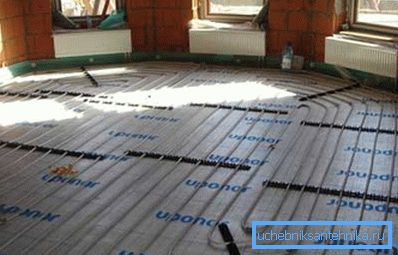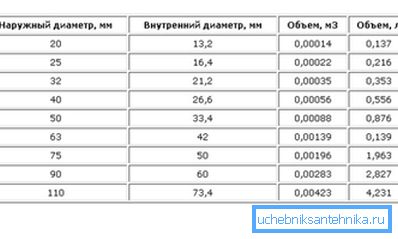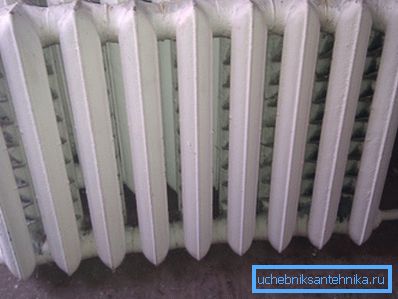The volume of water in the pipe and in the heating system as
The question of how to calculate the volume of water in a pipe arises when designing various systems based on a pipeline. For example, calculate the approximate water content required when planning an autonomous heating system.
When autonomous heating in a country house is almost ready, you need to start the calculations in order to have the exact data necessary for the selection of the diameter of pipes and the corresponding model of the hydroaccumulator. Again, it is impossible to do without correct calculation of the volume of fluid in the pipe if you need to add antifreeze to the coolant or completely fill the system with antifreeze.

The need for proper counting of water in the heating system

The question is, is the volume of water in the meter of a pipe so important if it is possible to pour liquid into the system until it is filled up to the very neck?
It turns out that the need for accurate calculations is obvious. Moreover, the volume in some cases will need to be counted not only in pipes, but also in heating radiators. For example, when designing a heating system, you need to have accurate information about the amount of coolant in order to select a boiler with the appropriate power parameters.
Another reason for the correct calculations is the use of pumping equipment. In this case, it is necessary to know the amount of the transported medium at the rate of so many cubic meters per a certain unit of time.
Knowing the right amount of water in various pipes, you can choose not only the appropriate pipe sizes, but also the required pump capacity.
Calculation of the coolant content in the pipe

Despite the fact that you can use the calculator of the volume of water in the pipe, it is better to do such calculations yourself (read also the article Diameters of polypropylene pipes: everything you need to know for beginners).
The fact is that automated costing is performed using averaged algorithms, whereas if you count yourself, you can take into account the configuration features of the pipeline and other nuances that the online calculator cannot take into account.
- Before you calculate the volume of water in the pipe you need to understand that the internal space in the plumbing system is a cylinder of great length.
- Knowing that we have to calculate how capacious the cylinder is, we apply the formula known from the physics lessons: V =? * R? * H, where:
V is the volume of the cylinder;
? - 3.14 (pi number);
R is the radius;
H - height.
- Another formula will be useful if you know the area of the base of the cylinder: V = S * H, where S is the area of the base, and H is the height.
Important: Representing the pipeline in the form of an extended cylinder, you need to understand that H will not be the height, but the length of the pipe, the capacity of which in liters should be calculated.
Calculation of the coolant content not only in the pipeline, but also in the system as a whole

The question of how to calculate the internal volume of pipes separately from the heating system is rarely worth it. More often, it is necessary to perform a calculation taking into account the heating batteries of the boiler and the expansion tank, if such is provided for in the system used.
Instructions for the calculation in this case is as follows:
- At the initial stage, we measure the length of the pipeline without taking into account the hydroaccumulator (batteries). Having decided on the length, we consider the volume according to the formula V =? * R? * H, where “H” will be the length that we previously measured.
Of course, the resulting number will be approximate, but the difference in nominal and working volume of the system can be compensated for when it is filled with coolant.
- At the next stage, we consider how capacious the heating radiator is.

It’s no secret that batteries of different sizes can be used in one building site, which is explained by different parameters of the premises. That is why the calculation is carried out not on the radiator as a whole, but on each individual section.
This method is relevant for cast-iron and aluminum radiators, which are usually divided into sections. As a rule, to fill each section you need at least 1.5 and not more than 2 liters.
If you plan to install bimetallic or steel batteries with your own hands, we look at the packaging parameters or on the product itself.
- The capacity of other equipment, including the heating boiler and the vegetable tank, is determined in accordance with the passport data or designations printed on the case.
If there is no accompanying documentation for the expansion tank, you can fill this container with water and then drain the entire contents into a measuring container and thus determine the volume.
Important: When calculating the amount of coolant in the heating system, you need to take into account what material the pipes are made of. For example, the walls of steel products are an order of magnitude thinner than the walls of polypropylene analogs with seemingly the same diameter.
Design features of closed heating systems

We note immediately that the instructions provided for conducting calculations are relevant only in relation to heating facilities of a closed type. After all, in closed systems, the amount of coolant is characterized by consistency.
In order to understand how the water behaves in enclosed structures and why the previously proposed calculation schemes were necessary, consider the device of the most common modifications of autonomous heating.
An autonomous heating system is considered closed in the event that the amount of coolant remains unchanged, and it is driven by a circulation pump. Such a modification of heating, as a rule, is absolutely hermetic and the coolant is not in contact with the environment. The water pressure in the mixer varies due to thermal expansion, but is compensated by the expansion tank, which is installed separately.
However, most modern gas heating boilers are equipped with integrated expansion tanks, which greatly simplifies the design and assembly of the system as a whole. In this case, counting the volume of the tank separately does not make sense, since the required amount of coolant is indicated in the passport documentation of the heating boiler.
Conclusion
Now we know how to correctly calculate the amount of coolant in the heating system and make it so that the operating cost of this system is acceptable. There are any questions that need clarification (see also the article Calculation of the diameter of a pipe for heating is an important stage in the design of the heating system).
In this case, watch the video in this article.